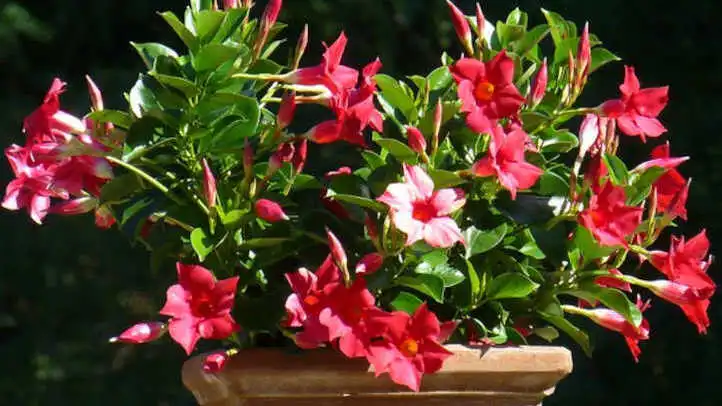If you are looking for a vibrant and low-maintenance plant to add a tropical touch to your garden or living space, look no further than the Rio Dipladenia. This beautiful tropical plant is known for its lush foliage and eye-catching trumpet-shaped flowers that come in various colors, including red, pink, white, and raspberry splash.

This exotic beauty is not just a visual delight but also a pollinator magnet, making it an irresistible addition to any garden or living space. Let’s dive into the world of Rio Dipladenia and discover its key features and care guidelines that make it a true tropical gem.
Key Features of Rio Dipladenia
- Non-Stop Blooming: Emphasize the non-stop blooming nature of Rio Dipladenia, which ensures a continuous display of beautiful flowers throughout the growing season.
- Pollinator Attraction: Discuss how the trumpet-shaped flowers of Rio Dipladenia attract pollinators like butterflies and hummingbirds, enhancing the biodiversity of the garden.
- Compact and Bushy Growth: Describe the plant’s compact and bushy growth habit, making it suitable for smaller spaces and a great choice for adding a tropical touch to balconies and patios.
- Aromatic Fragrance: Mention the pleasant fragrance emitted by some varieties of Rio Dipladenia, adding an extra sensory delight to your garden.
Care Guidelines for Rio Dipladenia
- Sunlight Requirements: The Rio Dipladenia thrives in full sun, so ensure it receives a minimum of 4 hours of direct sunlight daily. Whether in your garden or indoors, place it near a sunny window to bask in the nourishing rays.
- Watering with Caution: Maintain a well-draining medium for your Rio Dipladenia to avoid waterlogged roots. Water the plant when the top 5 cm (2 inches) of soil is dry. Be mindful not to overwater, as it can lead to root rot.
- Effortless Beauty: No Deadheading Required: Unlike many other plants, the Rio Dipladenia does not require deadheading. As its blooms naturally fade and fall off, the plant rejuvenates itself, producing fresh flowers without the need for pruning.
- Winter Protection: The Rio Dipladenia may struggle to live in areas where temperatures fall below 7 degrees Celsius (45 degrees Fahrenheit). To protect it during winter, bring the plant indoors before the first frost. Place it near a sunlit window to ensure it continues to thrive.
Propagation Methods of Rio Dipladenia
- Stem Cuttings: Explain the process of propagating Rio Dipladenia through stem cuttings, from selecting the right cuttings to providing the ideal growing conditions.
- Seed Propagation: Discuss the option of propagating Rio Dipladenia from seeds, including seed collection, preparation, and nurturing of seedlings.
Rio Dipladenia vs Mandevilla Plant
Rio Dipladenia and Mandevilla are closely related tropical flowering plants known for their vibrant, trumpet-shaped blooms and climbing habits. While they share similar characteristics and are often confused, there are some key distinctions between them.
Rio Dipladenia (Mandevilla sanderi ‘Rio’) is a specific cultivar of Mandevilla. It typically has smaller leaves and flowers compared to other Mandevilla varieties. The Rio Dipladenia displays a profusion of blossoms in shades of pink, red, or white.
Mandevilla, on the other hand, refers to a broader genus of climbing plants with larger leaves and flowers. Mandevilla hybrids (usually Mandevilla x amabilis) showcase bigger, showier flowers in various colors like pink, red, yellow, and white.
Both plants require similar care, thriving in warm climates with well-draining soil and ample sunlight. They are excellent choices for adding tropical flair to gardens, patios, and trellises, but Rio Dipladenia’s smaller size might make it more suitable for compact spaces. In summary, Rio Dipladenia is a specific type of Mandevilla with slightly smaller blooms, while Mandevilla encompasses a broader range of climbing plants with larger, more diverse flowers.
Conclusion
The Rio Dipladenia is undoubtedly a tropical delight that can transform any garden or living space into an oasis of beauty. With its lush foliage and trumpet-shaped flowers in various vibrant colors, it is a feast for the eyes and a magnet for butterflies and hummingbirds.
Caring for the Rio Dipladenia is a breeze, as it requires minimal effort to maintain its stunning appearance. Just remember to provide it with enough sunlight, water it appropriately, and give it some shelter during the colder months if you live in a chilly climate.
So, if you’re looking to add a touch of the tropics to your surroundings and create an inviting space for pollinators, consider adding the Rio Dipladenia to your garden. Its non-stop blooming and low-maintenance nature will ensure you have a breathtaking display of colors all season long with little to no hassle. Happy gardening!
FAQs
Q1: Is Rio Dipladenia an annual or perennial plant?
Rio Dipladenia is a perennial plant, meaning it can live for multiple years under suitable growing conditions. With proper care, it can thrive and bloom year after year, adding long-lasting beauty to your garden or living space.
Q2: Can Rio Dipladenia tolerate full sun?
Absolutely! Rio Dipladenia thrives in full sun and requires at least 4 hours of direct sunlight daily for healthy growth and abundant blooms.
Q3: Can I plant Rio Dipladenia in a hanging basket?
Absolutely! Rio Dipladenia is an excellent choice for hanging baskets, adding a burst of color and tropical charm to your outdoor space.
Q4: Does Rio Dipladenia attract pollinators?
Yes, Rio Dipladenia’s vibrant flowers are irresistible to butterflies and hummingbirds, making it a pollinator-friendly addition to your garden.
